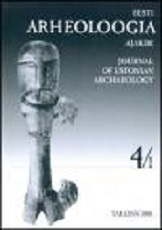TRACING PREHISTORIC MIGRATION: ISOTOPE ANALYSIS OF BRONZE AND PRE-ROMAN IRON AGE COASTAL BURIALS IN ESTONIA
TRACING PREHISTORIC MIGRATION: ISOTOPE ANALYSIS OF BRONZE AND PRE-ROMAN IRON AGE COASTAL BURIALS IN ESTONIA
Author(s): Ester Oras, Valter Lang, Liivi Varul, Marge Konsa, Gurly Vedru, Martin Malve, T. Douglas Price, Eve Rannamäe, Jana Limbo-Simovart, Margot LanemanSubject(s): Archaeology, Ancient World
Published by: Eesti Teaduste Akadeemia Kirjastus
Keywords: TRACING PREHISTORIC MIGRATION ; ISOTOPE ANALYSIS ; BRONZE AND PRE-ROMAN ; IRON AGE ; COASTAL BURIALS ; ESTONIA ;
Summary/Abstract: There have been various explanations in archaeological literature about whether the earliest Bronze Age stone-cist graves and the first Pre-Roman Iron Age tarand graves in Estonia were built by locals or non-locals. As to possible immigrations, the stone-cist graves have been often related to Scandinavian populations, whilst early tarand graves allegedly had roots in eastern directions. The oldest known examples of these cemetery types are at Jõelähtme and Muuksi for stone-cist graves, and at Ilmandu and Kunda for early tarand graves, in the coastal zone of northern Estonia. In order to test the migration hypothesis we carried out a bioarchaeological study, measuring and mapping local biologically available Sr and O isotope ratios and analysing stable isotope signals of altogether eight individuals from these early stone-cist and tarand graves. The study material was chosen on the basis of the oldest AMS dates of skeletons available so far, or according to the earliest burial constructions in the cemeteries. Based on the comparison of local biologically available Sr and O isotopic baseline results and the results obtained from the individuals, we can talk about migrants in the case of two persons from Kunda and perhaps one from Muuksi, whilst most of the individuals analysed are of local origin. Thus, the idea of Early Metal Period migrations to Estonia from the surrounding regions is supported to some extent. However, the discussion of these migrations might turn out to be surprisingly different from what is expected on the basis of material culture. We also emphasise the importance of further analysis, especially mapping isotopic baseline data in the eastern Baltics, in order to draw further conclusions about the directions and extent of prehistoric migration in this region.
Journal: Eesti Arheoloogia Ajakiri
- Issue Year: 20/2016
- Issue No: 1
- Page Range: 003-032
- Page Count: 30
- Language: English

